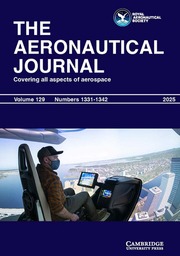No CrossRef data available.
Article contents
Dynamic characteristics and stability analysis of multi-body aircraft deployment process based on bifurcation theory
Published online by Cambridge University Press: 11 July 2025
Abstract
There are multiple equilibrium points in the launching and unfolding process of the multi-body aircraft. Different equilibrium points exhibit different stability characteristics and change with parameters such as connection method. The changes in stability characteristics can also lead to the inability of multi-body aircraft to achieve stable deployment. To solve these problems, the dynamic stability of multi-body aircraft during falling is analysed based on bifurcation theory in this paper. In this paper, Lagrange multiplier method is used to establish the multi-body dynamics model of the multi-body aircraft, and the curly spring torque model is added. In order to consider the coupling effect between the wings and the influence of the relative motion between the flight units on the aerodynamic force, the reference angle-of-attack, the reference sideslip angle, the relative attitude angle and the relative attitude angular velocity between the flight units were introduced as new variables to establish the aerodynamic model of the multi-body aircraft. Based on the equilibrium equations, the equilibrium curve of the two-body aircraft is obtained by using the joint stiffness coefficient as the continuous variable parameter. The stability of the equilibrium point domain on each equilibrium curve was analysed by using linearised theory. The dynamic characteristics of the launching and unfolding process of the two-body aircraft were analysed using bifurcation theory, and the stable domain was obtained regarding the initial folding angle and connection stiffness coefficient. The influence of initial folding angle and connection stiffness coefficient on the dynamic characteristics of the launching and unfolding process and the meaning of the stability domain were analysed through numerical simulation calculations. Finally, the correctness of the analysis conclusion was verified through experiments on the two-body aircraft, accumulating the technical foundation for subsequent research on high-altitude deployment.
Keywords
Information
- Type
- Research Article
- Information
- Copyright
- © The Author(s), 2025. Published by Cambridge University Press on behalf of Royal Aeronautical Society


